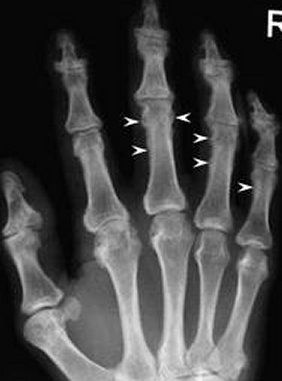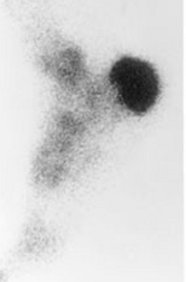Silent Arthritis and Enthesopathy in Patients with Psoriasis
Introduction
Since enthesopathy is often the primary abnormality in Psoriatic Arthritis then it would be anticipated that enthesopathy would be present in psoriasis cases before the onset of arthritis and joint swelling.
Since the 1970s numerous studies have shown skeletal changes in psoriasis patients but the link with enthesopathy has only recently emerged.
Most studies have been undertaken by Dermatologists and not Rheumatologists who are experts in joint examination.
When Rheumatologists examine Psoriasis cases they find evidence for Psoriatic Artritis in around a third of cases.
When Rheumatologists scan patients with psoriasis who don't have clinical evidence of arthritis, a high prevelance of joint abnormalities is still evident. These abnormalities are not associated with pain.
The key to understanding enthesopathy in psoriasis is recognising that the enthesis is more than just an insertion but forms a structure called an enthesis organ which contains a synovio-entheseal complex (SEC) which is integrated into the adjacent bone.
This section gives an overview of abnormalities evident on x-raying or scanning joints of psoriasis patients where the patients have not reported symptoms of joint pain or swelling.
Imaging the Skeleton in Psoriasis Cases
X-Rays
Psoriasis patients who have X-rays of the spine often show bone changes in the sacroiliac joint that is termed sacroiliitis [1, 2].
X-Rays of the hands may occasionally show new bone formation or periostitis of the pattern evident in the image below.
 |
Occasionally patients with psoriasis may have diffuse new bone growth or proliferation on the bone surface (arrrowheads). This may cause no symptoms. We believe that is may be secondary to enthesis organ inflammation with associated inflammatory reaction in the underlying bone (osteitis) and periostium. |
These bone surface changes may be due to a reaction in the bone surface (periosteum) that in turn is secondary to diffuse underlying bone inflammation (osteitis).
Abnormalities can be seen in the bones at other locations also.
Bone scintigraphy or radio-isotope bone scanning
In the 1970s it was shown that uptake of radioactive chemicals that specifically bind to bone was common in psoriasis cases [3].
Preliminary evidence suggests that the increased uptake of bone seeking isotopes suggestive of bone inflammation (osteitis) in psoriasis patients may improve following drugs like methotrexate [4].
The basis for the diffuse bone abnormalities evident in psoriasis may relate to the functionally integration of the enthesis and bone with the enthesis being anchored to the underlying bone like the roots of a tree to the ground.
 |
 |
| Patients with psoriasis, Psoriatic Arthritis, and the related Spondyloarthropathies may may diffuse uptake of radioactive chemicals that show preferential uptake in the bone. It is now known that insertions are joined to bone in a manner like to roots of a tree to the ground. These bone changes may be extremely painful in patients with Psoriatic Arthritis. These abnormalities may also occur at sites where there is no pain in Psoriatic Arthritis and can also occur in Psoriasis subjects. | |
A more sophisticated type of bone scanning called positron emission tomography has also shown uptake in the skeleton in psoriasis cases [5].
Ultrasound
Enthesopathy as measured by ultrasound is very common subjects with psoriasis who do not have clinical arthritis further suggesting that it is the primary abnormality.
One study showed occult enthesopathy related changes in a third of cases [6].
Another large study showed that nearly 12% of insertions scanned in psoriasis patients had evidence for enthesopathy [7].
Ultrasound determined enthesopathy is seen in up to 50% of psoriasis cases [8]. The changes include new bone formation and also changes of inflammation at insertions [8].
The presence of clinically silent enthesopathy in psoriasis appears to be associated with the subsequent evolution of Psoriatic Arthritis [9].
Synovitis or joint swelling in Psoriatic Arthritis may be linked to dysfunction of the enthesis where it forms a tissue structures called synovio-entheseal complexes (SECs) [10].
Nail disease in patients with psoriasis is a predictor of subsequent Psoriatic Arthritis. It has now being demonstrated that the nail is anchored directly to the skeleton by ligament and tendon entheses (Link to Nail page).
Nail psoriasis in the finger nails is linked to enthesopathy in the lower limbs [11].
Magnetic Resonance Imaging
There is limited Magnetic Resonance Imaging studies showing skeletal abnormalities in psoriasis but changes compatible with enthesopathy have been reported [12].
Things that is important to know if you have psoriasis
The extent of psoriasis has little to do with the chances of developing joint pain.
Young people with extensive psoriasis may not develop joint pain and Psoriatic Arthritis.
In patients with scalp and nail psoriasis the incidence of Psoriatic Arthritis is higher.
Psoriasis patients do not need joint scans if they have no symptoms. This is still a research question and cannot be used to guide treatment.
Research is ongoing to determine whether abnormalities on scanning can be used to predict which patients are at risk of Psoriatic Arthritis [13].
References












